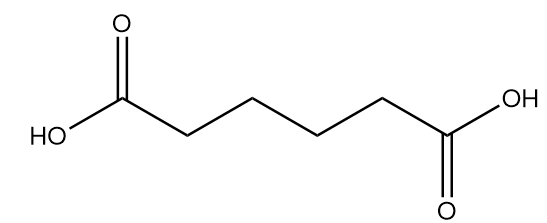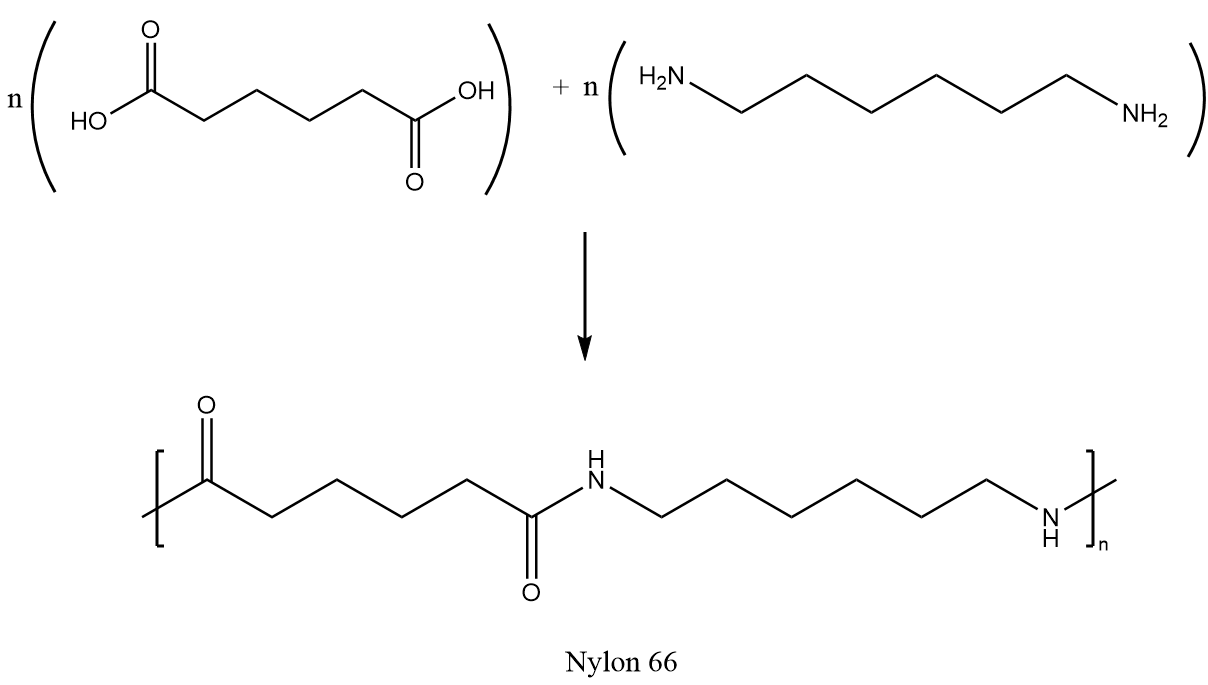
Answer
382.5k+ views
Hint: A substance consisting of very large molecules or consisting of long chain repeating units are known as polymers. The small units which form the polymers are known as monomers. The polymers are of two types i.e., natural polymer and synthetic polymer.
Complete answer: Nylon 6-6 is a synthetic polymer which is also called polyamide. The numbers describe the type and quantity of the polymer chain in the chemical structure. It is composed of two monomers which are hexamethylenediamine and adipic acid. The structures of the monomers of Nylon 66 are as follows:
Adipic acid:

Hexamethylenediamine:

Nylon 6,6 can be synthesized by a polycondensation reaction of adipic acid and hexamethylenediamine followed by the polymerization reaction. The synthesis reaction is as follows:

Hence, Nylon 6,6 is a synthetic polymer.
So, option (B) is the correct answer.
Additional information:
Some important properties of Nylon 6,6 are as follows:
-These polymers have high mechanical strength, hardness, stiffness and toughness.
-These polymers provide good resistance to high radiation energies like gamma and x ray.
-The water absorption rate for these polymers is comparatively lower than other polyamides.
-These polymers have good electrical insulating properties i.e., are good insulators of electricity.
Note:
It is important to note that the major difference between Nylon 6 and Nylon 6,6 polymers is mold shrinkage. The polymer nylon 6 has lower mold shrinkage which adds reliability to stuff whereas in nylon 6,6, due to its greater mold shrinkage, the shape of material or stuff changes by exposing it to cool air.
Complete answer: Nylon 6-6 is a synthetic polymer which is also called polyamide. The numbers describe the type and quantity of the polymer chain in the chemical structure. It is composed of two monomers which are hexamethylenediamine and adipic acid. The structures of the monomers of Nylon 66 are as follows:
Adipic acid:

Hexamethylenediamine:

Nylon 6,6 can be synthesized by a polycondensation reaction of adipic acid and hexamethylenediamine followed by the polymerization reaction. The synthesis reaction is as follows:

Hence, Nylon 6,6 is a synthetic polymer.
So, option (B) is the correct answer.
Additional information:
Some important properties of Nylon 6,6 are as follows:
-These polymers have high mechanical strength, hardness, stiffness and toughness.
-These polymers provide good resistance to high radiation energies like gamma and x ray.
-The water absorption rate for these polymers is comparatively lower than other polyamides.
-These polymers have good electrical insulating properties i.e., are good insulators of electricity.
Note:
It is important to note that the major difference between Nylon 6 and Nylon 6,6 polymers is mold shrinkage. The polymer nylon 6 has lower mold shrinkage which adds reliability to stuff whereas in nylon 6,6, due to its greater mold shrinkage, the shape of material or stuff changes by exposing it to cool air.
Recently Updated Pages
Who among the following was the religious guru of class 7 social science CBSE

what is the correct chronological order of the following class 10 social science CBSE

Which of the following was not the actual cause for class 10 social science CBSE

Which of the following statements is not correct A class 10 social science CBSE

Which of the following leaders was not present in the class 10 social science CBSE

Garampani Sanctuary is located at A Diphu Assam B Gangtok class 10 social science CBSE

Trending doubts
A rainbow has circular shape because A The earth is class 11 physics CBSE

Fill the blanks with the suitable prepositions 1 The class 9 english CBSE

Which are the Top 10 Largest Countries of the World?

How do you graph the function fx 4x class 9 maths CBSE

The Constitution of India was adopted on A 26 November class 10 social science CBSE

Give 10 examples for herbs , shrubs , climbers , creepers

Difference between Prokaryotic cell and Eukaryotic class 11 biology CBSE

The Equation xxx + 2 is Satisfied when x is Equal to Class 10 Maths

Change the following sentences into negative and interrogative class 10 english CBSE




